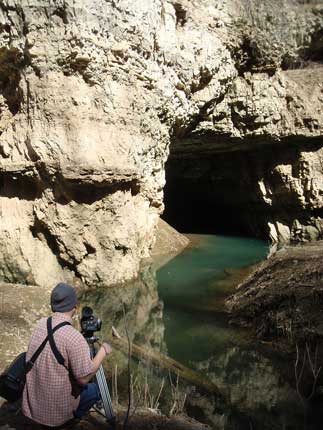Tumbling Creek Cave
This Registered Natural Landmark has two miles of known passage and glistens with stalagmites and stalagtites.
The cave is home to the most diverse group of cave creatures west of the Mississippi River, including eight species of bats, blind salamanders, and many insects. Two of the cave's species are found nowhere else in the world. One is a millipede that lives in bat guano; the other is a tiny snail. |
 |
 Link to 12 more photos taken when the crew shot video in Tumbling Creek Cave and the recharge area above it during March 2009. Link to 12 more photos taken when the crew shot video in Tumbling Creek Cave and the recharge area above it during March 2009.
 Link to Tumbling Creek Cave Foundation Link to Tumbling Creek Cave Foundation |
Above: Even though video crew members carried in bright lights, this vast chamber's 60-foot ceilings swallowed much of the illumination. Tumbling Creek runs through the room; it is fed by runoff from a nine-square-mile area. |
 |
Grand Gulf
Sometimes called "The little Grand Canyon," Grand Gulf is a mile-long sunken area which formed when a cave roof collapsed. Located near Thayer, Mo., it is now a state park. The steep-sided Grand Gulf features a natural bridge, breathtaking tall bluffs, and the cave shown at left.
 Link to seven more photos taken when the video crew shot on location at Grand Gulf in the spring of 2009. Link to seven more photos taken when the video crew shot on location at Grand Gulf in the spring of 2009.
 Link to Grand Gulf State Park Link to Grand Gulf State Park |
| Above: Videographer Neil Rosenbaum captures video of light playing on water droplets as they fall from the cave roof and then echo when they hit the still pool below. |
|
Mammoth Spring
Rising silently from an underground shaft beneath a big pool is Mammoth Spring, third largest spring in the area highlighted in the karst video. This spring is the source of Arkansas' Spring River. |
 |
 Link to five more photos taken when the video crew visited in April 2009. Link to five more photos taken when the video crew visited in April 2009.
 Link to Mammoth Spring State Park Link to Mammoth Spring State Park |
Above: Springwater flows over a dam built early in the 1900s to generate hydroelectric power. The old turbine is on public display in the building to the right of the dam. |

